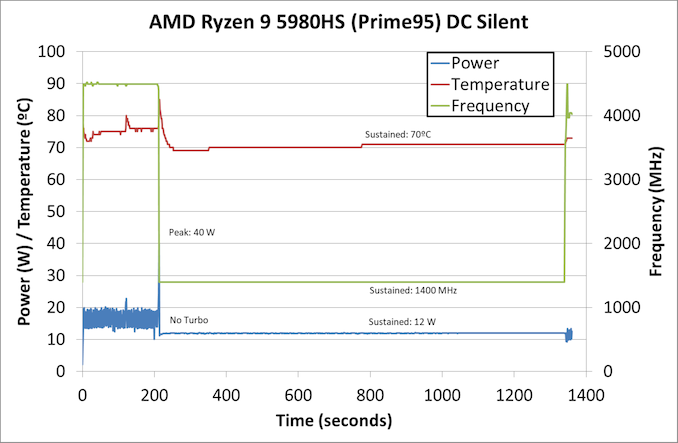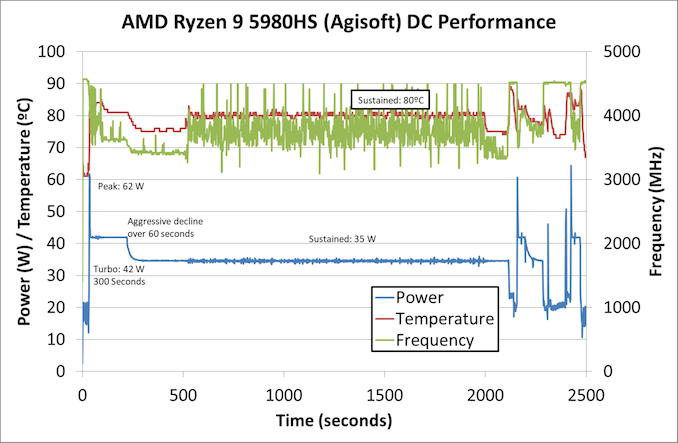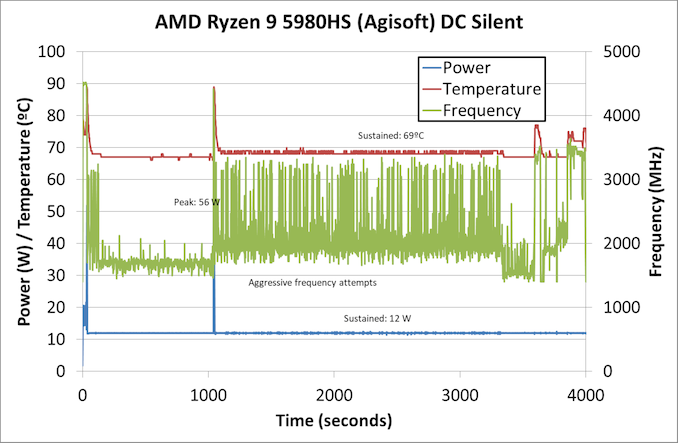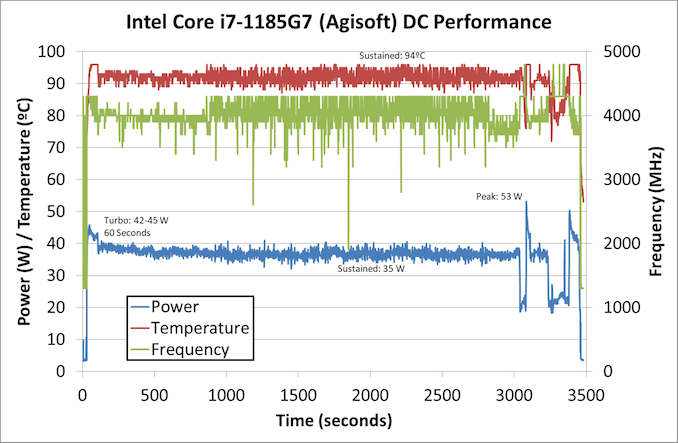AMD Ryzen 9 5980HS Cezanne Review: Ryzen 5000 Mobile Tested
by Dr. Ian Cutress on January 26, 2021 9:00 AM EST- Posted in
- CPUs
- AMD
- Vega
- Ryzen
- Zen 3
- Renoir
- Notebook
- Ryzen 9 5980HS
- Ryzen 5000 Mobile
- Cezanne
Power Consumption
The nature of reporting processor power consumption has become, in part, a dystopian nightmare. Historically the peak power consumption of a processor, as purchased, is given by its Thermal Design Power (TDP, or PL1). For many markets, such as embedded processors, that value of TDP still signifies the peak power consumption. For the processors we test at AnandTech, either desktop, notebook, or enterprise, this is not always the case.
Modern high performance processors implement a feature called Turbo. This allows, usually for a limited time, a processor to go beyond its rated frequency. Exactly how far the processor goes depends on a few factors, such as the Turbo Power Limit (PL2), whether the peak frequency is hard coded, the thermals, and the power delivery. Turbo can sometimes be very aggressive, allowing power values 2.5x above the rated TDP.
AMD and Intel have different definitions for TDP, but are broadly speaking applied the same. The difference comes to turbo modes, turbo limits, turbo budgets, and how the processors manage that power balance. These topics are 10000-12000 word articles in their own right, and we’ve got a few articles worth reading on the topic.
- Why Intel Processors Draw More Power Than Expected: TDP and Turbo Explained
- Talking TDP, Turbo and Overclocking: An Interview with Intel Fellow Guy Therien
- Reaching for Turbo: Aligning Perception with AMD’s Frequency Metrics
- Intel’s TDP Shenanigans Hurts Everyone
In simple terms, processor manufacturers only ever guarantee two values which are tied together - when all cores are running at base frequency, the processor should be running at or below the TDP rating. While manufacturers showcase a rating on the box, motherboard manufacturers often ignore it and use their own settings, based on the motherboard capabilities, making the CPU vendor ratings somewhat useless. The crucial thing is though, the CPU vendors actively encourage the motherboard vendors doing their own thing, creating confusion as to the real power consumption for the workload, and if the frequency on the box is actually what the user is going to get.
For laptops, it gets even worse than desktops. On a laptop, power consumption and frequency control are key parts of the design ethos, however we end up with nested-upon-nested options for power control. While the CPU vendor will have their own power control levels in firmware, the laptop vendor will have another set on top of this in the BIOS, and then the operating system will have another set on top of this, followed by another layer of laptop vendor software. Its turtles all the way down, and each variation produces something quite different.
AMD recommends that all the power levels be left where they are, and the user only controls the vendor software power options. In this case ASUS offers two modes: Silent and Performance. We mentioned these on the first page of this review, and showcased some odd numbers. It might be more striking if I just show the comparison.
To start, I’m simply going to showcase what a full sustained 10 minute CPU load does, first in Performance mode.
P95 is a heavy AVX workload for this processor, and in performance mode we see the processor peak at 56 W for a couple of seconds, and then hit its turbo mode at 42 W for 300 seconds. During this time we’re around 4000 MHz on all eight cores and sixteen threads, and the system cooling is keeping it around 80ºC. Once the 300 seconds has finished, the system slowly decreases to 35 W and 75ºC over the course of 60 seconds, before hitting a consistent 35 W. The frequency bounces as low as 3200 MHz, likely in line with the instructions from the test.
Now similarly, let’s go to the same benchmark in ‘Silent’ mode.
This looks a lot different. Here the system is prioritizing noise over anything else, and that also means reducing voltages and frequencies to the point of absurdity. There is no turbo to speak of in this workload, and the system comes down to 1400 MHz sustained at 70ºC and 12 W. This is still all eight cores, and the system is still quiet, but that is the tradeoff in these designs.
Moving to a more user-friendly workload, Agisoft, which is a mix of ST and MT.
At the start of the test we see the power peak at 62 W for a second or two, before coming down to a 300 second turbo of around 42 W. During this time the frequency comes down to around 3650 MHz, before reducing to 3400 MHz as the turbo budget runs out and the system drops to 35 W for a sustained mode. The second part of the test, which is multi-threaded, starts at around 500 seconds and showcases a sustained temperature of around 81ºC and an opportunistic frequency peaking at 4500 MHz, all while staying at 35 W. Towards the end of the test, as we start looking at single threaded workloads, the system peaks above 60 W on two occasions, but also shows 4500 MHz for ST activity. The CPU temperature rises more to 90ºC as the preferred core is used, but as it is only a single core the thermals are better managed and adjust accordingly.
The same workload in silent mode stays at 12 W for almost the entire test. We get a couple of peaks to 56 W, but the system tries to both stay quiet and stay around 68-69ºC by reducing frequency and power. The CPU still tries to remain opportunistic as we can see from the very spikey frequency graph in green, but it is in the region of 1700 MHz to 3300 MHz for most of the test. So while it takes 2443 seconds in performance mode, the same test takes 4059 seconds in silent mode.
This is probably showcasing the worst performance disparity between the two. In a lot of CPU tests, as you’ll see in this review, the differences can be minor. It showcases just how important it is to profile what workload you are running, and keep a close eye on what performance mode the system is running at (there isn’t a clear sign without actively checking the software).
Suffice to say however, in these tests, we do see a peak of 62-65 W on the Ryzen 9 5980HS. It is for all intents and purposes the briefest of spikes, and we don’t necessarily see any thermal increase to the extent that another 10 seconds of workload at 42-45 W does. The sustained turbo mode for 300 seconds is an impressive turbo mode that allows for higher frequencies in most workloads, with only the super sustained tests that might be more at home on a workstation or 15-to-17-inch notebook causing the processor to hit 35 W TDP. It also comes down to thermals, and given the design and temperatures we’re seeing, the ROG Flex 13 is very much a notebook, than a ‘laptop’. Users looking to actually use it on their lap would probably be best creating a thermal profile that keeps the temperature low at the expense of fan noise. When we examine the laptop in further detail, we’ll cover the issue of fan noise.
For completeness, here’s the Agisoft graph for the MSI Prestige 14 Evo in performance mode. Intel enables a turbo of 60 seconds, on which we see 42-45 W, although the peak observed is 53 W later in the test. We do see a sustained 35 W mode, averaging around 4000 MHz on all four cores. But what is perhaps worrying is the temperature, being reported as a sustained 92-94ºC on average. That’s quite high. Where the Ryzen 9 5980HS takes 2443 seconds to complete the benchmark, the Intel system takes 3389 seconds.















218 Comments
View All Comments
Spunjji - Monday, February 1, 2021 - link
I'm aware of all of the above, but it still doesn't justify the original claims being made - and "Potentially also on the menu would be a faster peak clock rate" is nothing but speculation. Based on what we know about the design and the relatively poor clock scaling in respect of TDP shown between the A14 and M1, I'd say it's extremely unlikely that Apple will be able to push clocks up by more than a couple of hundred megahertz without a significant redesign.What Apple will most likely have in that TDP range is something that's performance-competitive with Cezanne on the CPU side in native applications, significantly outclasses it on the GPU side, and maintains a perf/watt advantage commensurate with the node advantage that largely disappears when running translated code.
It's still far better than what Intel have, but it's not going to redefine the industry. If that order of advantage were enough to do so, then AMD wouldn't have existed after 2007.
GeoffreyA - Sunday, January 31, 2021 - link
"Apple will outclass everything x86 once they introduce their second gen silicon"I've noticed the idea circulating is that the M1 is Apple's first-generation CPU. Sure, it may be the first one going into a computer, but as far as I'm aware, the M1 descends from the A14, which goes back to the A6 of 2012. How many iterations is that? Nine? Granted, some might be "ticks," but this certainly isn't a brand-new design. Zen 3, despite borrowing from Athlon, Bulldozer, and Core, is on its 3rd iteration, or 4th if one counts Zen+.
Lucky Stripes 99 - Tuesday, January 26, 2021 - link
Not only have iGPUs cannibalized the sub-$100 discrete GPU market, but they have also chewed into the cool and quiet GPU market. If you have a HTPC or compact mITX system, your options aren't that great. I'd really like a GTX 3060L on a low profile PCIe card, but I won't hold my breath.Also, I love the return of the 16:10 screen format. I'd kill for a 27" desktop version of the X13's screen with the same resolution and color coverage.
DigitalFreak - Tuesday, January 26, 2021 - link
What's the problem with integrated graphics in a HTPC?Lucky Stripes 99 - Tuesday, January 26, 2021 - link
New features tend to come slower to iGPU parts than to discrete GPU parts. As example, it used to be very difficult to build a 4K60p system with a Raven Ridge APU because so few boards supported HDMI 2.0. Likewise, you're often stuck with an older video decoder/encoder than what is available on the discrete GPU market. Luckily the only feature missing from the latest generation of AMD parts is hardware AV1 decoding which will come with the RDNA2 APUs next round.dudedud - Tuesday, January 26, 2021 - link
I thought you will be including the M1 in more benchmarks besides GB and SPEC.:/
danwat1234 - Tuesday, January 26, 2021 - link
"But what is perhaps worrying is the temperature, being reported as a sustained 92-94ºC on average. That’s quite high. " --> 94C is fine, the silicon is rated to handle it 24/7. What is strange to me is that it most of the tests, the CPU temperature stays in the 80s, when there is more thermal headroom to go. It could clock higher.Fulljack - Wednesday, January 27, 2021 - link
80°C means either you have a glaring jet sound on your laptop fans or downclock it enough to keep it quite.Deicidium369 - Wednesday, January 27, 2021 - link
quite what?and pretty sure glaring refers to vision, while blaring refers to SPL
abufrejoval - Tuesday, January 26, 2021 - link
I wonder why you peg the mobile 8-core against a desktop 6-core instead of the 5800X...?Having the various 8-cores side-by-side allows a much better understanding of how architecture and power settings compare generally.
BTW tried do the manual comparison via Bench, but it seems the Chezanne results aren't in there yet.